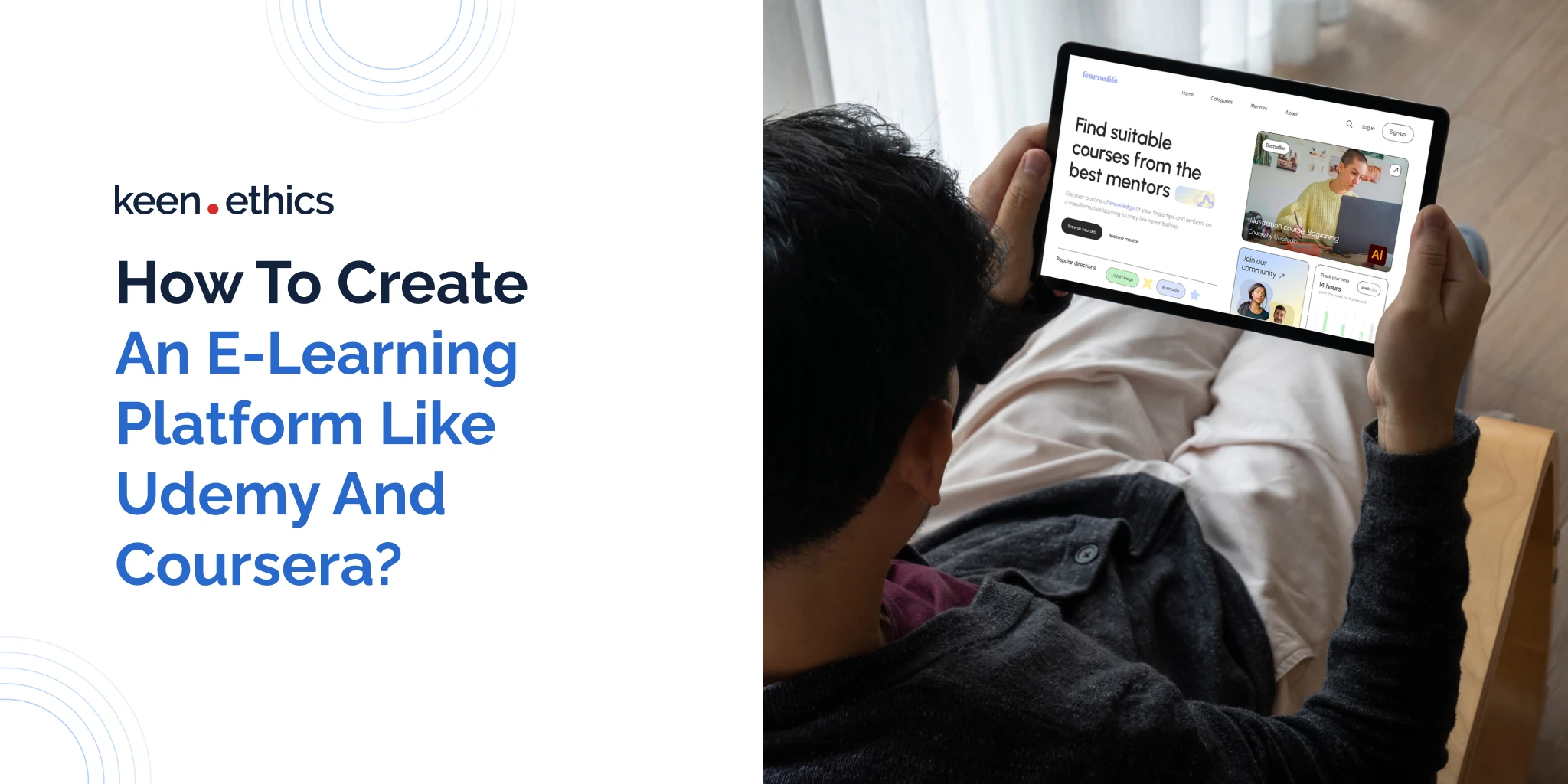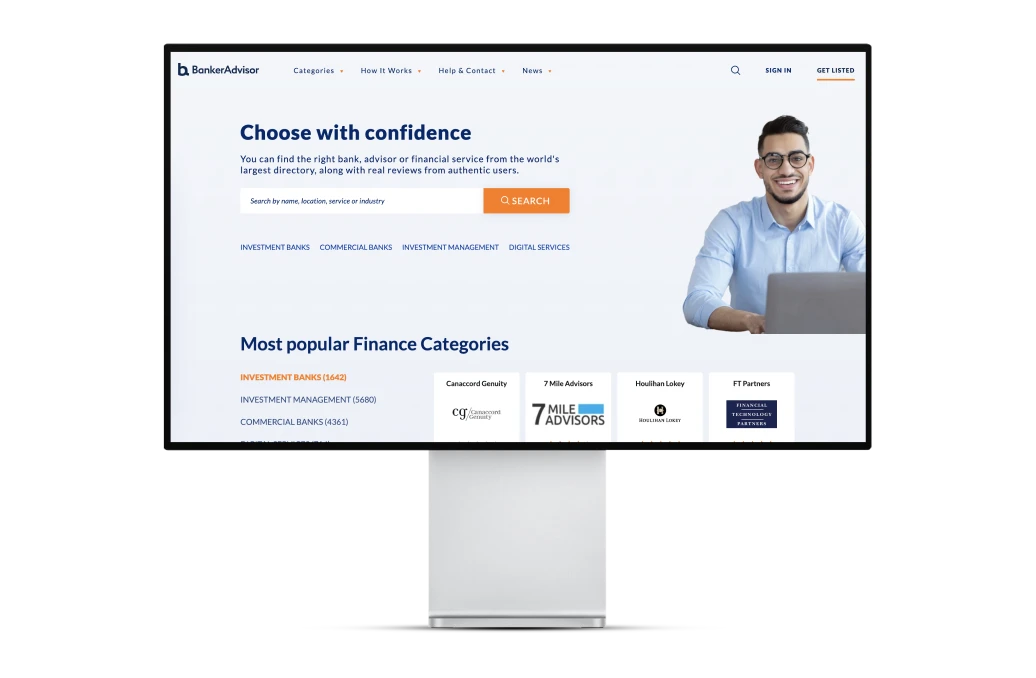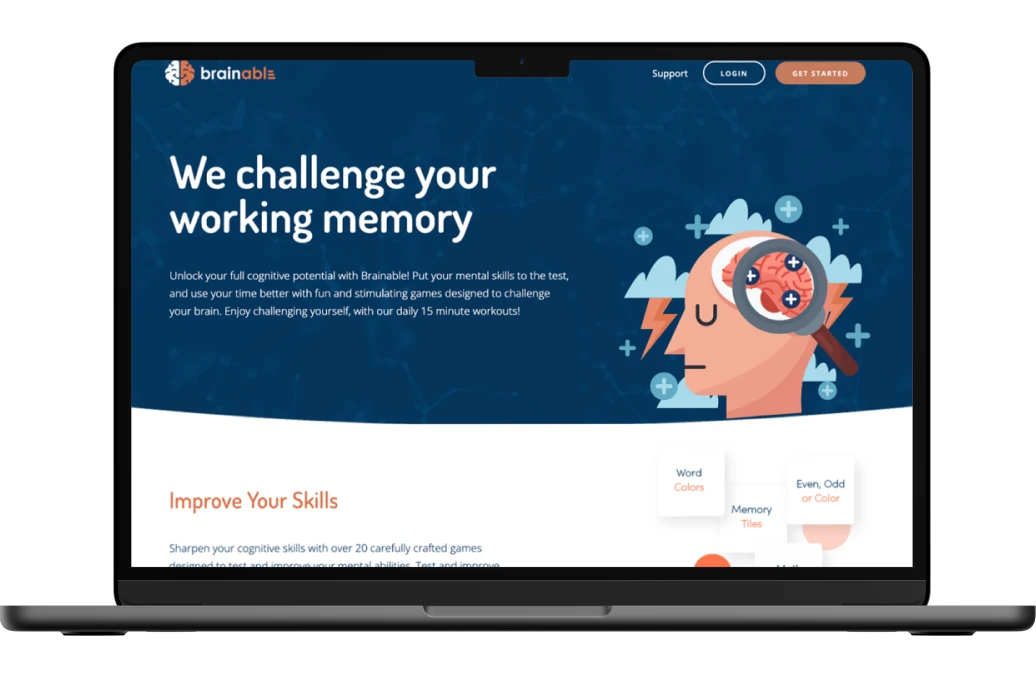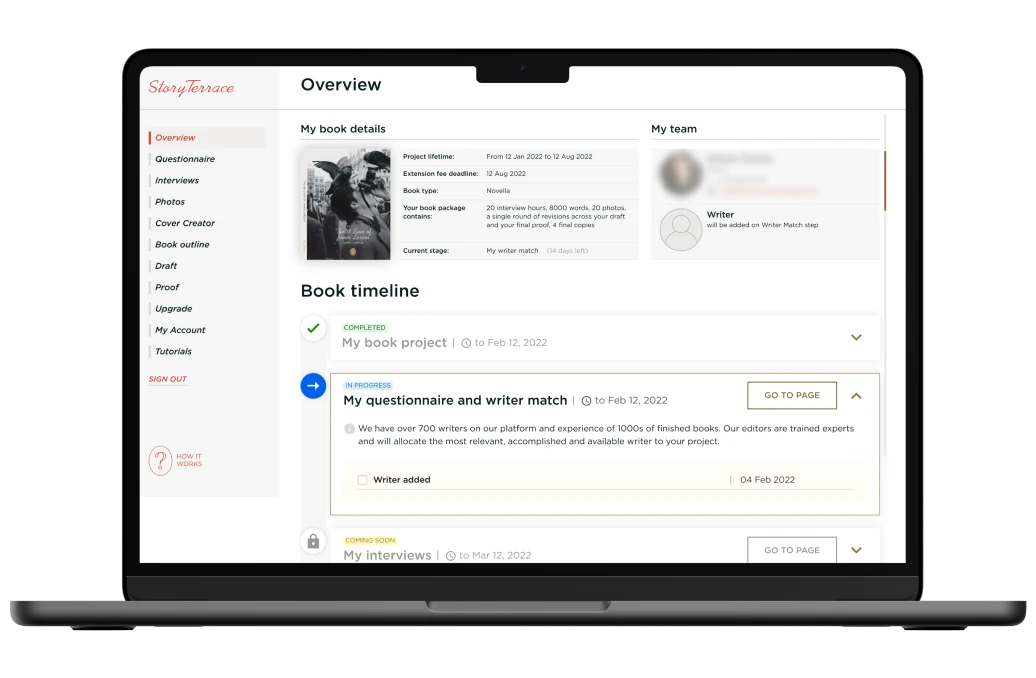Do you want to start an e-learning platform? You’ll learn how to do this in this article!
Modern Internet offers its users many benefits. The opportunity to transform education via e-learning software is among them. Platforms such as Udemy and Coursera tremendously impact the current market. Why? They allow people to educate themselves without going to school or college. Undoubtedly, services of this type will play a vital role in the future of education. Do you want to create an e-learning website? In such a case, this article will greatly help you. We review the business models of e-learning websites, their types, and the key features one should consider for such sites.
Comparison of Coursera vs. Udemy
Coursera and Udemy have similarities and differences: both platforms are education-centric but target slightly different needs. Coursera primarily partners with renowned universities and institutions to offer curated courses, often focusing on academic subjects. It emphasizes structured learning with a set start and end date, providing certifications upon completion. In contrast, Udemy is an open marketplace where anyone can create and sell courses on various topics, including professional development and hobbies. It delivers a vast library of courses with lifetime access, allowing learners to study at their own pace. Udemy courses are typically more affordable and suited for self-directed learners, while Coursera provides a more structured and academic learning experience. Why are those platforms so important from the standpoint of business? They give strong insights on how to create an e-learning platform.
Key reasons why Udemy and Coursera are successful
How to build a website like Udemy or Coursera? We need to understand why they’re so popular at first. Let’s review them in depth:
1) Comfortable tools for course creation: both Udemy and Coursera offer advanced tools for course creation. In common practice, this means that you won’t face major challenges while building your course, either through native or third-party tools.
2) Large number of learning options: Udemy and Coursera are notable for the numerous courses available on them. In this regard, potential users have the ability to discover alternatives for a wide range of topics, encompassing topics like philosophy and programming.
3) Strong credentials: users can often get high-quality certificates for the courses they’ve passed. Thus, platforms like Coursera offer tangible benefits via their digital learning platform.
How Do Online Learning Websites Work?
If you’re reading this article, you likely want to understand how modern online learning websites function. To create an e-learning website, you need to first understand the overall concept behind such projects. Online learning websites work by providing a platform where individuals can access educational materials and courses over the Internet. These websites typically deliver a range of courses on various subjects and are often structured with video lectures, quizzes, assignments, and discussion forums. Users can enroll in courses, access the content at their own pace, interact with instructors and fellow learners, submit assignments, and track their progress. Some platforms also award certifications or degrees upon completion of certain programs. In short, they offer access to a full array of information necessary for mastering certain concepts.
eLearning Platforms’ Business Model
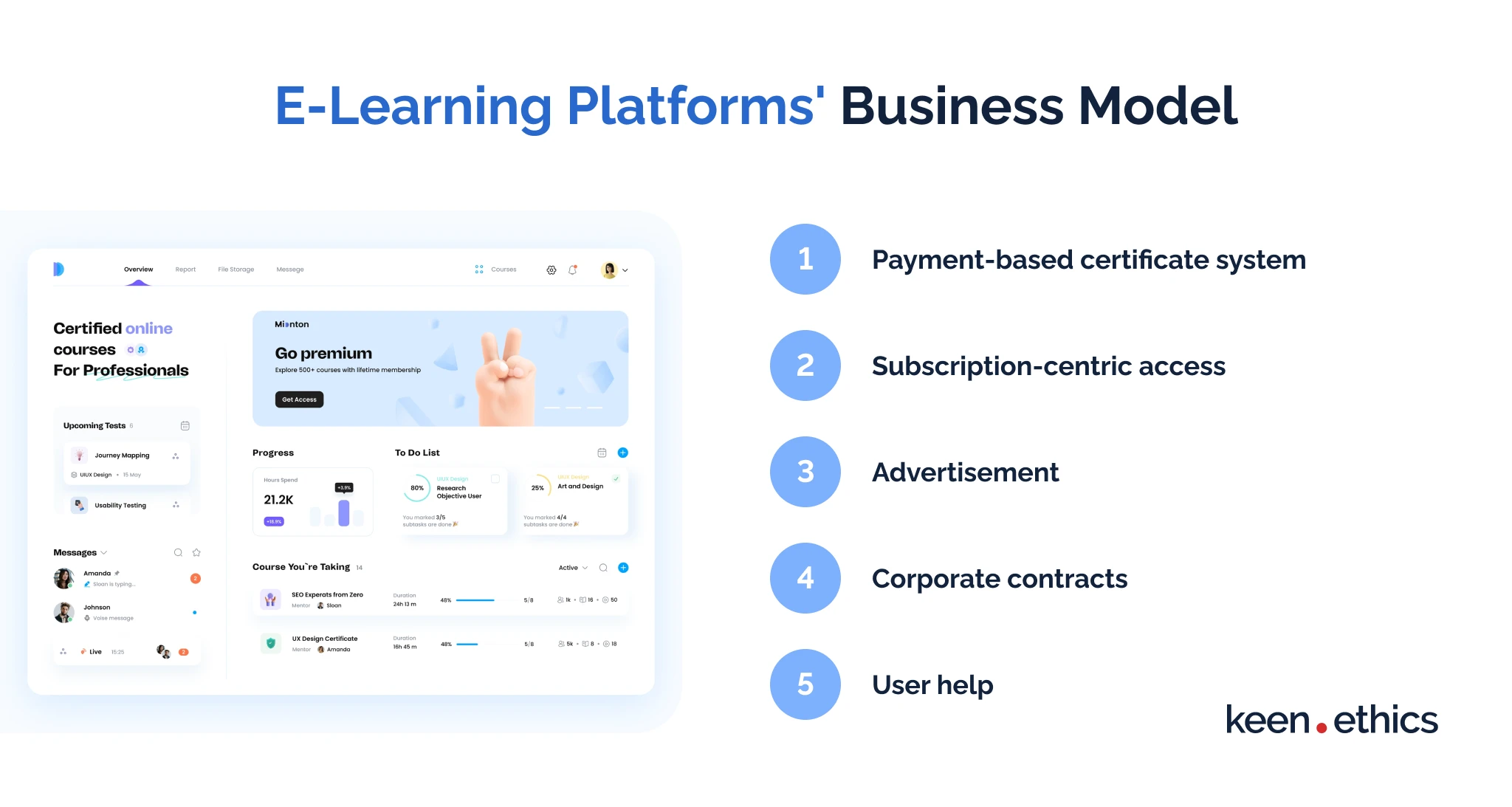
When you build an e-learning website (and any other project), it’s crucial to answer one central question: what is its business model? How is it going to earn funds? Without understanding those factors, you risk creating a popular business that would nonetheless fail due to the problems with monetization. We know many examples of companies failing due to this issue. The ideas below will help you overcome this problem if you invest in creating an online learning platform:
1. Payment-based certificate system
The first way to earn funds is to offer the customers an opportunity to get certificates for their efforts via a certain fee. How does this work? The course can be free, but to get proof of completion, one has to pay. Some courses, such as CS50, may boost employment chances due to their reputation and connection to top schools such as Harvard, as Fortune reports. In this light, investing in a certificate is a great idea. If you expect many high-quality courses on your site, monetizing the certificates is a great idea for creating an online learning platform.
2. Subscription-centric access
Another way to earn on courses is to offer access through a subscription. This can be done in multiple ways. One may charge funds for access to all courses. It’s also possible to ask for payment regarding particular courses. Everything depends on the complexity of the relevant material and the willingness of the partners with whom you work. In our opinion, a combination of options functions well, too: for example, newer and more complex courses can get separate subscriptions; older ones can become a part of the general subscription package.
3. Advertisement
Most sites, such as Udemy and Coursera, are perfect for advertisers. They provide high-quality content that is safe for work. In this light, you’ll likely attract many advertisers to your service. Companies promoting other learning services or delivering devices that enhance learning are likely to prioritize online e-learning platforms in their activities. Are you afraid the site users may be angry about such monetization? Offer advertisement for free users and a no-advertisement option for the premium ones. Many people will likely perceive such an approach as sufficiently fair.
4. Corporate contracts
All firms on the market greatly care about the quality of their workforce. This means they need major investments in the training of the relevant employees. This is exactly what online courses offer. Why are corporate contracts so important for various e-learning services? Many companies order courses for many people (sometimes, thousands of individuals can be involved). This means you can earn large sums from cooperation with enthusiastic clients who are genuinely willing to study. One large contract with a firm may cover your expenses for a whole year (granted that the company is a large-scale market leader, for instance).
5. User help
Certain users are also willing to donate to various services they use constantly. Donations are a perfect way to go outside the confines of conventional payment frameworks. For example, some people may be willing to donate small sums that are below the threshold of your premium services. Others may deliver massive support, which will be much larger than any service-oriented payments possible within a platform. By opening a pathway for donations, you give the users a chance to customize their investments. If your goal is creating an online learning platform that’s about being free (as in freedom), the best choice is to configure a strong basis for donations.
What Are the Core Reasons for Creating a Course Site like Udemy and Coursera?
Before learning how to develop a website like Udemy, let’s learn about the core reasons to consider solutions similar to this one. In our opinion, multiple reasons to create an online education website like Udemy or Coursera exist today. Yes, there are clear market leaders these days, and they create significant pressure on the market. Nonetheless, this doesn’t mean that you’ll not succeed:
Reason 1. Improving access to education
The first reason to invest in platforms like Udemy and Coursera is to improve access to education. We can review this aspect from two perspectives. Firstly, it’s essential to note that platforms like Udemy and Coursera typically target the most widespread languages on the Internet. The majority of the courses are in English, and only a small minority covers some other European languages. Consequently, people without the knowledge of English are completely cut off from access to education in such conditions. By creating your course platform, you can resolve this problem once and for all. For example, it’s a good idea to offer education in some languages of the Indigenous tribes in Latin America. Many of them have a strong demand for education, and your unique platform can cover those demands.
Reason 2. Covering non-mainstream topics
Secondly, the issue of platforms like Udemy and Coursera also lies in the limited coverage of the relevant course material. What do we mean by this? Most course platforms target mainstream knowledge, such as programming or biology. Often, no unique courses are targeting some specific areas of knowledge.
What are some of those areas that can benefit from an Udemy-like approach? You can cover board games, video games, obscure musical genres, and even meme creation. In short, many informal hobbies don’t fit into those websites, offering a great competitive environment. As a result, there’s still space for the creation of a unique learning management platform that covers some non-mainstream hobbies. For example, many people would be willing to pay for courses that teach them how to play deck-building roguelike games in principle.
All in all, the dominance of Coursera and Udemy doesn’t mean that there’s no space for your cloud-based platform.
Reason 3. Offering alternative business models
Udemy, for example, is highly notable for numerous paywalls in its course model. Coursera is less restrictive, but many of its free courses are less advanced than the paid ones. This means that the existing model of access to online courses may be suboptimal for certain users.
Thus, a serious reason to create a course platform like Udemy and Coursera is to consider alternative business models. What are some options here, in our opinion? Primarily, you can try to offer your customers the ability to change prices based on their region. Regional prices are one of the strongest ways to boost access for people in developing countries. Moreover, alternative monetization can involve advertisements of various kinds. Education platforms are known for having high-value audiences and, thus, they should be a highly attractive target for marketing specialists. In short, you can try to create platforms with a higher level of accessibility if you decide to enter this market. Competition touches upon not only core features, but also the ability to create alternative monetization models.
Must-Have E-learning Platform Features
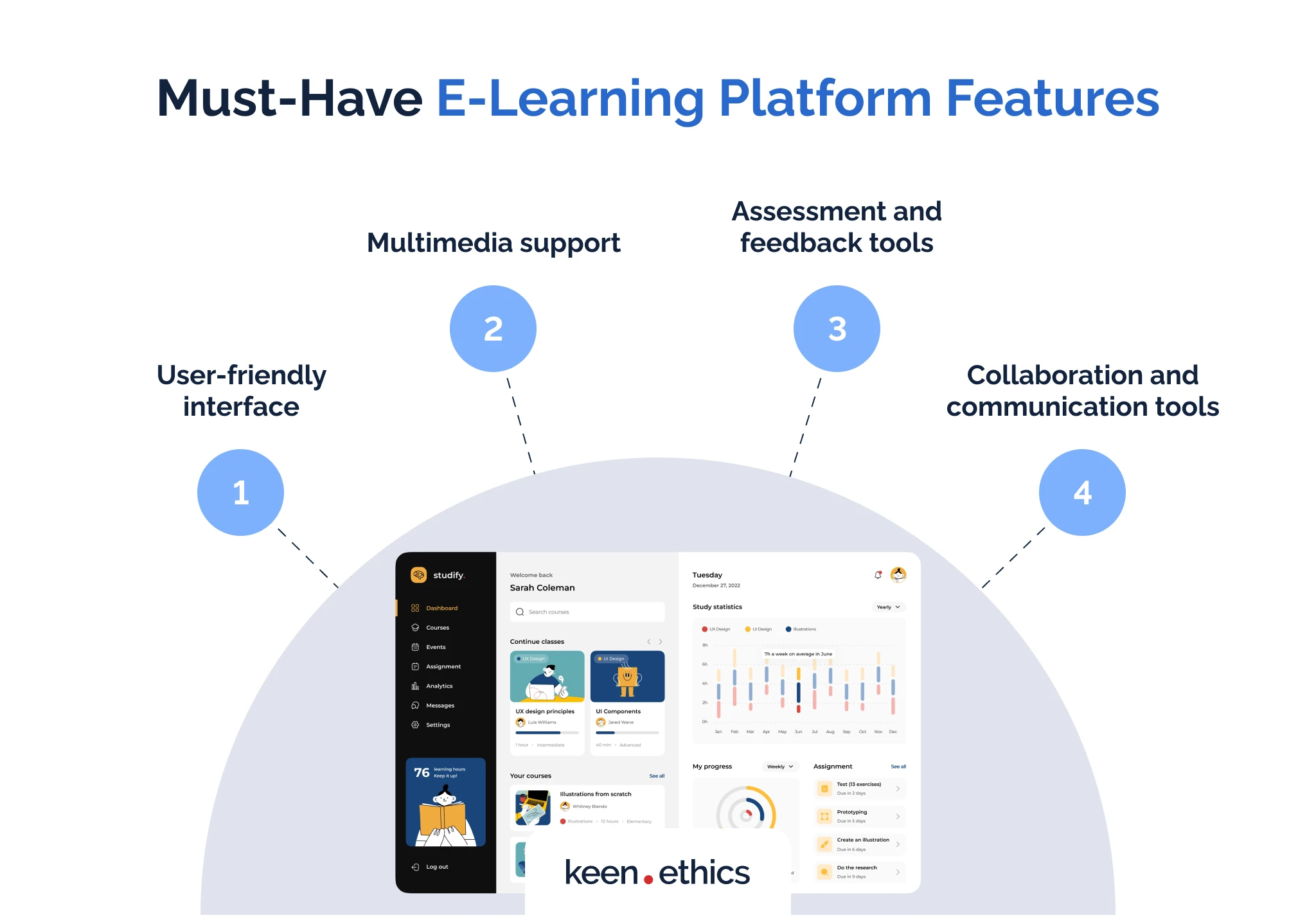
What are the key features to consider for an e-learning platform? How to build an e-learning platform that can deliver maximum usefulness for the clients? Here’s the list of the functions you need:
User-friendly interface
An e-learning platform should have an intuitive and user-friendly interface that allows learners to easily navigate and access course materials, assignments, and resources. Clear and organized layouts, simple menus, and easy-to-use features provide a positive learning experience. Why is this so important? People with different skill sets can access your platform: some may have great computer literacy, and others may have trouble understanding computers. The difference between age groups also is important: complex interfaces create a major barrier for older adults and children. What’s the rule of thumb here? The simpler, the better.
Multimedia support
E-learning platforms should support multimedia content such as videos, interactive presentations, and audio recordings to enhance engagement and understanding. The ability to incorporate visual and interactive elements enriches the learning experience and caters to different learning styles. Some people like learning from videos. Others find audio and images much more interesting. Allow everyone to maximize their skills.
Assessment and feedback tools
Effective e-learning platforms include built-in assessment and feedback tools. These features enable instructors to create quizzes, assignments, and exams to evaluate learners’ progress and provide timely feedback. Such tools foster active learning and help track performance and understanding for students. They’re also great for the teachers. Why? These tools minimize the amount of time one needs to spend to create quizzes, for instance. This offers a chance for instructors and teachers to learn more about ways to enhance their professional knowledge. Instead of spending time on routine tasks, such as assessments, they get a chance to improve their knowledge of many key processes.
Collaboration and communication tools
E-learning platforms should provide features for learners to interact with instructors and peers, such as discussion forums, messaging systems, and virtual classrooms. These collaboration tools facilitate group discussions, knowledge sharing, and real-time communication, promoting an interactive and social learning environment. Why are they so important? Such tools enable users to receive relevant feedback regardless of their location. With collaboration and communication tools, one can study from any location. They remove all limits, making education as accessible as possible.
Best E-Learning Platforms
Are you interested in e-learning platform development? An important practice to consider is the analysis of the existing success cases:
Coursera
Coursera is a popular e-learning platform that offers a wide range of courses from top universities and institutions worldwide. It’s successful due to its extensive course catalog, high-quality instructional materials, and interactive learning features. Coursera’s partnerships with prestigious universities and industry leaders contribute to its credibility, making it a trusted platform for learners seeking academic and professional development opportunities.
Khan Academy
Khan Academy is a non-profit e-learning platform known for its extensive collection of educational videos and interactive exercises. It offers free, accessible education for learners of all ages. Why is it so successful? The key positives of this platform include comprehensive content coverage, clear explanations, and adaptive learning features. Khan Academy’s mission to provide free education to anyone, anywhere, has made it a widely utilized and respected platform.
Docebo
Docebo is a versatile learning management system (LMS) platform that offers customizable e-learning solutions for businesses and organizations. It’s successful due to its user-friendly interface, robust course creation and management features, and powerful analytics tools. Docebo’s flexibility and scalability make it a preferred choice for companies seeking to effectively deliver and track employee training and development programs.
edX
edX is a renowned e-learning platform founded by Harvard University and MIT. It hosts a vast array of courses, including both free and paid options, covering diverse subjects. edX’s success stems from its prestigious university partnerships, rigorous course content, and interactive learning experiences. The platform’s commitment to providing accessible education and its focus on verified certifications make it highly regarded among learners and employers. One of the most famous programming courses in the world, CS50, appeared for the first time on this platform.
SkillShare
SkillShare is an e-learning platform that focuses on creative and practical skills. It offers a vast library of courses taught by industry professionals. SkillShare’s success lies in its engaging and project-based learning approach, allowing learners to apply what they’ve learned in real-world scenarios. The platform’s affordability, community features, and emphasis on hands-on learning make it appealing to individuals seeking to enhance their professional or creative skills.
How to Create an E-learning Platform?
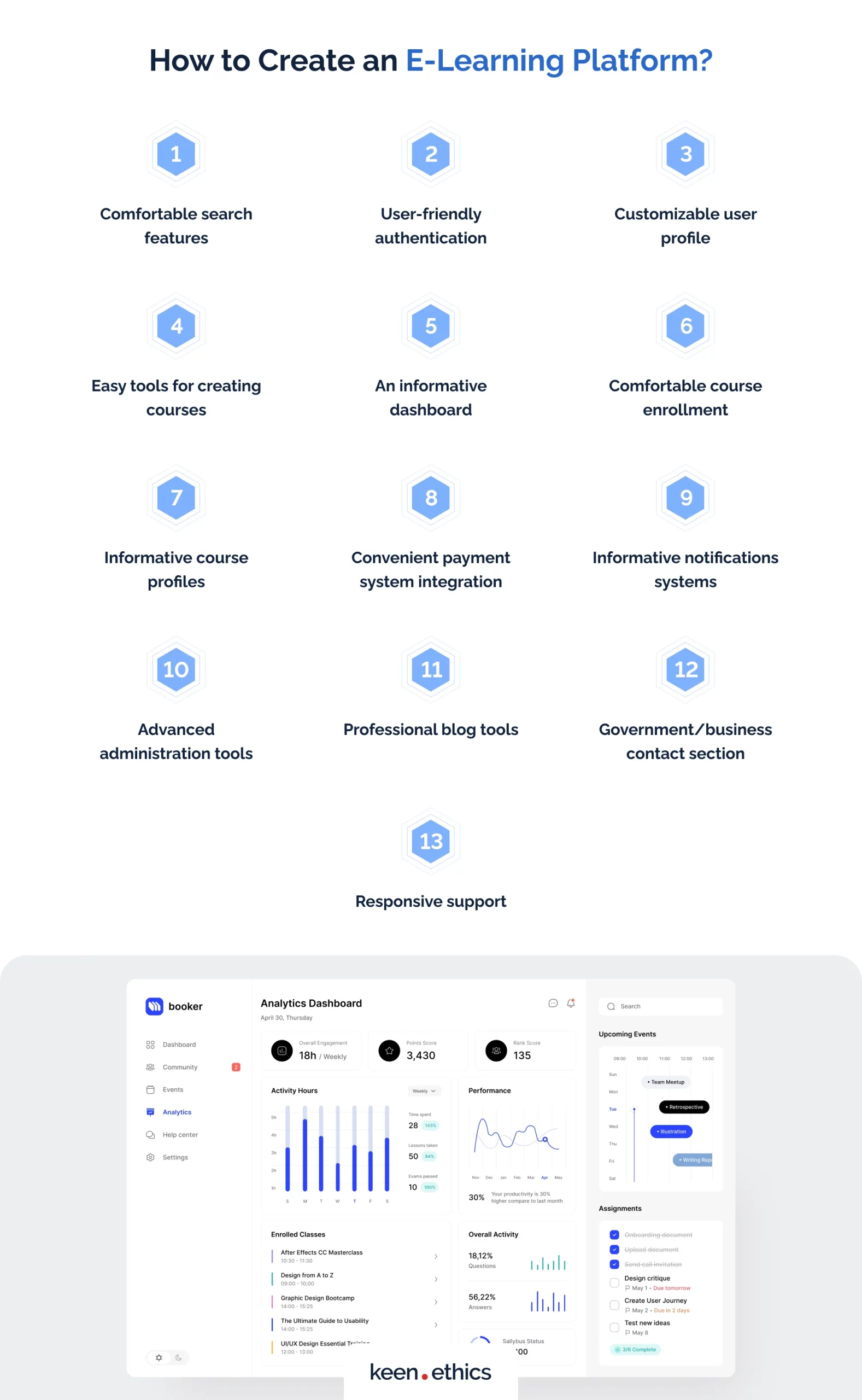
If you’re interested in e-learning platform development, it’s crucial to understand what features make them successful in the first place. Here’s the list of the key aspects one should add to the relevant platforms to develop an elearning platform that is successful:
1. Research and planning
Planning
The first step in the creation of any solution is the analysis of the existing market. Many products fail because they either provide the same service as that of the competitors or fail to offer anything of value, even if they’re unique. So, what are the core steps at this stage?
Above all, review the existing solutions on the market. Here, your goal is to understand what they’re doing and whether these projects are successful at covering customer needs. In many cases, a review of the existing solutions will quickly uncover some points of discontent among the customers. For example, the users of an e-learning platform may claim that it’s great, but then add that the framework lacks tools for proper interactivity.
The second step during the analysis stage is to review the gaps you’ve found during the primary analytical stage. You can add some additional procedures here: for instance, a set of online surveys point towards other problems on the market. Consequently, you’ll be able to see what gaps people identify in the market and what they truly want in terms of high-quality IT solutions for education.
Once the gaps are identified, you should also research the existing technologies. Sometimes, there are no solutions because they’re impossible. Full-scale capability analysis is of the essence for any type of proper enterprise planning.
Planning
If you conclude that your solution is of interest to the market and is viable technologically, it’s time to create a business plan. At this stage, we recommend the following steps:
1) Outline the core features of your app and test them through various methodologies: here, you can try prototypes or even Minimum Viable Products to see if your product fits the overall needs of the customers. In short, the goal is to test the hypothesis on the real audience. At this stage of planning, you should identify the optimal approach to your solution.
2) Create a development plan: once you have all the information, it’s essential to create a development plan. You must have a full understanding of the end product. Assemble a team and, using modern methodologies for project creation, deliver a full-scale plan for product delivery.
2. Choose a monetization strategy
Key problems of monetization
A key problem of many companies in the education market lies in their inability to monetize their business. You require a correct combination of payment methods, such as subscription plans, to succeed. For example, many people like Duolingo and praise it, but it became viable financially only a year ago, in 2023. In short, the popularity of your product doesn’t necessarily mean that it will be successful financially. You can create a great learning platform, but it may simply be inefficient as a business.
Thus, you should start thinking about monetization before going for full-scale development. It’s not enough for your approach to be interesting to the users. If you’re not building a convenient tool for non-profits, then you must clearly define the key sources of revenue.
Core monetization strategies
In our opinion, the following strategies are the most efficient in terms of attracting a paying audience:
1) Combine subscription and per-course payments: the two most powerful platforms on the course market combine the presented revenue model approaches for payment gateway. It’s a major mistake to offer only per-course or subscription-based payment options to the users. Why? Let’s review those cases individually.
Let’s imagine that a person, say John, wants to quickly learn how to code in HTML. John needs this information for an optional programming course in their Ph.D. program. It’s highly beneficial for John to pay once and then not access your course program for several years. If you focus solely on subscriptions, then he’ll simply avoid your online education platform. Coursera, for example, wants 300 dollars per year for its course subscription platform. In practice, this means that a singular course can cost you at least 25 dollars per month. That’s the reason why Coursera also offers the ability to purchase courses individually instead of having to pay for them all.
Now let’s look at a different situation. Victoria wants to study drawing for a year. As a result, she may need numerous courses aimed at this skill. Victoria quickly calculates that the necessary courses may have an approximate cost of 1000 dollars per year if she buys them individually. Here, a 300-dollar subscription can be a major boon.
In short, your goal is to create as many options for which customers will be willing to pay as possible.
2) Offer regional prices: a big mistake many course creators make isn’t considering the audiences outside developed countries. There are millions and even billions of people in South Asia or Africa who are willing to pay for their education. Yes, they don’t have as many funds as people in developed countries. Nonetheless, the sheer number of buyers is likely to be so high that it’ll compensate for any price decreases. For example, few people there may be willing to pay 300 dollars per a year-long course. However, if you lower the price for those countries to 100 or even 50 dollars, you’ll attract thousands and, potentially, even millions of individuals. Many of them will be willing to pay even if you add some inconvenient features such as in-course advertisements. In short, price flexibility is an essential component of monetization here.
3. Define the required technology stack
A very important choice in the creation of platforms like Udemy and Coursera is the ability to choose the proper tech stack that fits both mobile devices and websites. So, how to build a website like Udemy or Coursera? Here are some insights into the tech stack you’ll need for this goal. In this regard, different platforms may demand different solutions:
Technical stack for building a website like Udemy
How to build a website like Udemy? Udemy is notable for its focus on individual course creators. People can go on the platform and build their full-scale courses by using the internal tools of the site. In practice, this means that the tech stack of Udemy is likely to require slightly different technologies than that of Coursera. So, what options should you be looking for in the presented case?
1) A highly responsive and user-friendly frontend: Udemy allows one to focus on creating their course through internal tools on the site. Thus, it requires many strong instruments with a strong response rate. In this regard, we can recommend platforms like React.js. They allow one to come up with flexible frontends that enable the developers to target as many people as possible.
2) A scalable backend: courses should have the capability to withstand significant demand from the users. Hence, a good idea is to go for platforms like Node.js. They allow one to handle many simultaneous connections at the same time.
3) A user-friendly API: since Udemy is focused on individual courses, the most rational solution when creating a framework like it is to focus on user-friendly options. Here, you should combine the ability to simply create a course through an interface with support for some common low-complexity standards like SCORM.
Technical stack to build a website like Coursera
The technical stack for building a website like Coursera is going to be more complex than in the case of Udemy. So, what should you do?
1) Complexity-centric frontend: Coursera focuses more on highly interactive materials and has more complex courses. Consequently, your goal is to use more processor-intensive technologies for the frontend. Here, something like Vue.js may be more advantageous. This platform is less flexible, but it has many optimizations aimed at improving its long-term speed. As a result, it may be better for the more complex elements that sites like Coursera demand.
2) CPU-intensive backend: in this case, a CPU-intensive backend may be a much better option for development. What should one include in the presented case for such a framework to function well? We recommend focusing on languages such as Python and C++ during development. Ruby and Java can also work in some specific use cases. Node.js is a possible solution, but you’ll need to optimize the functioning of its worker threads.
3) Support for complex formats: lastly, a major factor is the support for complex formats such as AICC and XAPI. Since Coursera focuses on the more complex media, it makes sense to create a framework where advanced but non-user-friendly platforms are being used en masse.
4. Design and Development
Design
A big aspect of success for any type of app is the ability to create a potent design for it. In this regard, you should pay attention to the following must-have features:
1) User-friendly interface: your interface must be easy to understand for the majority of users. Categories and menus should be easy to access. This is especially important for education because, to a great extent, it requires significant expenditure of mental resources. In this light, a lack of intuitiveness can genuinely undermine the majority of the learners and make their user experience highly inefficient.
2) Good aesthetics: it’s not enough for the interface to be user-friendly. Web 1.0 also had a fair share of user-friendly interfaces. One should also actively consider the overall aesthetics of your solution. Here, you must look into the information about the optimal color schemes. A good idea is to hire a designer who will be able to offer advanced input at this stage.
3) High speed: a site can be user-friendly and look fantastically, but be extremely slow. Your tech stack is capable of solving the majority of the problems in this regard. However, a viable solution here is to also consider making the elements of your site as lightweight as possible. In this regard, we recommend hiring a web development team that will be able to engage in content management and test it for speed.
Development
Before the launch, it’s also essential to actively think about the development processes in your firm. Here, the goal of the managers is to create optimal processes that won’t hinder long-term development.
In this regard, we recommend the following approaches:
1) Choose an optimal development framework: the most popular option here is Agile. You should develop in sprints and then focus on improving upon your processes during every iteration of development.
2) Assemble a strong team: it’s essential to find a team of specialists with sufficient knowledge of all the core technologies used in your business. In this respect, a good approach is to find an outside team through outsourcing. If you already have a team, then finding additional specialists is also possible via outstaffing. We at Keenethics are offering additional service of this kind to our customers. Don’t hesitate to contact us if you need help of this kind.
5. Choose a platform for setting up your website
In the end, the final step you should consider is choosing the right platform for setting up your website. So, what should your steps be at this stage? In our opinion, they must involve the following elements:
1) Consider the location which you’re going to target: your servers and educational platform for the promotion of a collaborative learning framework must be geographically close to the target audiences. In this case, one must pick servers and cloud storage locations that are in your region.
2) Actively focus on security: many education courses are collecting a significant amount of information on the personal activities of the customers. For example, a psychological course may require a lot of self-reflection. As a result, you should do as much as possible to protect the identity of your customers. For this reason, online courses need platforms that have a serious attitude to security. Usually, such platforms are the larger players in the market, such as Amazon.
3) Choose the platform that can scale: lastly, your choice must involve a significant degree of scaling. Many online platforms for boosting learning outcomes work with a significant number of individuals. More importantly, success can quickly lead to the doubling of the audience. In this situation, you must have enough capabilities to respond to this growth of the customer base through expanding server or cloud capabilities.
How Much Does It Cost to Develop an E-Learning Platform?
The cost of developing an e-learning platform can vary depending on various factors. These include the platform’s complexity, features, customization requirements, technology stack, design, and development resources. On average, the costs for developing a basic e-learning platform may range from $10,000 to $50,000, while more advanced and customized platforms can cost upwards of $100,000 or more. It’s essential to consult with experienced developers and discuss your specific requirements to get an accurate estimate for your e-learning platform development project. In our service, an average hour of developer’s time amounts to prices between 25 and 50 dollars. If you’re interested, don’t hesitate to contact us about the relevant services.
Our Experience in E-Learning Platform Development
Keenethics has major experience in developing e-learning platforms. What do we mean by this? We’ve developed multiple e-learning projects over eight years of experience in the field. Among the projects that we’re proud of are apps such as Brainable, which helps users improve their memory and logical thinking skills.
Conclusion
All in all, investments in learning platforms can pay off. Multiple companies have achieved success in this sector. We don’t recommend copying the existing solutions. But, if you know some niche, then it makes sense to invest in the sector to create a unique product. In case you want professional help with such development, don’t hesitate to contact us. We at Keenethics know how to deliver projects of the greatest quality. Address us, and we’ll offer advanced recommendations regarding your project in the online learning sector.
FAQs About Creating an Online Learning Platform
What do I need for an e-learning website?
To set up an e-learning website, you need a reliable hosting provider, learning management system (LMS) software and educational content.
What features should be present in an e-learning platform?
An e-learning platform should have features such as course management, multimedia support, assessments, progress tracking, and communication tools.
What’s the cost of an average e-learning platform?
The cost of an average e-learning platform can range from $10,000 to $50,000, depending on the platform’s complexity and features.
What’s the labor cost for development in the online learning sector?
Everything depends on the region and the relevant company. In the case of Keenethics, an hour of work on the part of the specialist costs between 25 and 50 dollars (depending on the skills of the involved individuals and the complexity of the work).
Contact us: we can consult you on the relevant idea and provide specialists for development.

